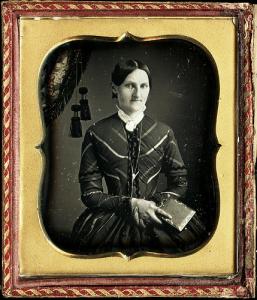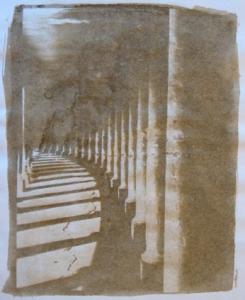
Daguerreotype of Unknown Woman c. 1850
Photos. We all have them. With the advent of the digital camera we find ourselves snapping them like there is no tomorrow. Millions of pixels stored on something the size of your thumbnail... prints available in just one hour. It wasn't always this simple.
Though often considered an art, photography has historically been all chemistry. The first commercialized photographic imaging technique, the daguerreotype, consisted of a copper plate, coated in silver and then exposed to iodine vapor.
Once the plate had been exposed to light (and we are talking exposures on the order of minutes - far longer than the 1/100 of a second our cameras do today) the image was rendered with mercury vapor and made permanent with a salt mixture.
That's a lot of chemistry right there.
Exposing the polished Silver coating to iodine vapor produces the following reaction:
2 Ag + I2 --> 2 AgI
The layer of AgI is light sensitive. Exposure to light produces the following reaction:
AgI + h? --> Ag + I
So the portions of the plate exposed to light consist of Ag, the ones unexposed consist of AgI.
Exposing the plate at this point to mercury vapor causes an amalgam to form in the portions exposed to light:
Ag + Hg --> Ag(Hg)
The last step, the water and salt mixture wash, removes the unexposed AgI:
AgI + 2S2O32- --> [Ag(S2O32-)2]3- + I-Recently Wired magazine had a great article ("History Exposed" Aug 2010) about a series of daguerreotypes taken in 1848 along the Cincinnati waterfront. The daguerreotypes are not only beautiful, but have preserved a moment in history and offer the present a glimpse into what life was like in the city in the middle of the 19
th century with amazing detail (far exceeding that of the most sophisticated digital camera on the market today).
Some of these images can be viewed here.
Most modern black and white prints are gelatin silver prints - where silver halide salt crystals are suspended in a thin gelatin layer (both film and paper). These crystals are the reason why some images can appear grainy (larger crystals, higher
film ISO, more light sensitivity). Daguerreotypes don't have this issue because the surface of the plate is pure and light exposure is decided by each individual molecule as opposed to a whole grouping of molecules.

Print by author made using the gum bichromate process
After the daguerreotype, countless new methods for capturing and preserving images came to light: salted paper prints, Wet plates, dry plates, cyanotypes, albumen prints and gum bichromate prints just to name a few.
The gum bichromate process (also known as the gum dichromate process) is actually pretty simple to perform. It requires a mixture of Potassium Dichromate solution, gum Arabic and pigment to be brushed onto a paper and dried. It is simple to make a contact print from a large format negative: place the negative on top of the light sensitive paper and lay it out in the sun for approx 20 minutes.
The sunlight causes the exposed emulsion (the bichromate specifically) to undergo a redox reaction which causes the gum Arabic to cross-link and become insoluble. The unexposed emulsion rinses off with water .
Though many people have made the switch to digital to preserve their memories of family and friends, some artists and hobbyists still use some of the older techniques, continuing to use them for the beauty and chemistry of it all.
Related articles by Zemanta
 Daguerreotype of Unknown Woman c. 1850
Photos. We all have them. With the advent of the digital camera we find ourselves snapping them like there is no tomorrow. Millions of pixels stored on something the size of your thumbnail... prints available in just one hour. It wasn't always this simple.
Though often considered an art, photography has historically been all chemistry. The first commercialized photographic imaging technique, the daguerreotype, consisted of a copper plate, coated in silver and then exposed to iodine vapor.
Once the plate had been exposed to light (and we are talking exposures on the order of minutes - far longer than the 1/100 of a second our cameras do today) the image was rendered with mercury vapor and made permanent with a salt mixture. That's a lot of chemistry right there.
Exposing the polished Silver coating to iodine vapor produces the following reaction:
2 Ag + I2 --> 2 AgI
The layer of AgI is light sensitive. Exposure to light produces the following reaction:
AgI + h? --> Ag + I
So the portions of the plate exposed to light consist of Ag, the ones unexposed consist of AgI.
Exposing the plate at this point to mercury vapor causes an amalgam to form in the portions exposed to light:
Ag + Hg --> Ag(Hg)
The last step, the water and salt mixture wash, removes the unexposed AgI:
AgI + 2S2O32- --> [Ag(S2O32-)2]3- + I-Recently Wired magazine had a great article ("History Exposed" Aug 2010) about a series of daguerreotypes taken in 1848 along the Cincinnati waterfront. The daguerreotypes are not only beautiful, but have preserved a moment in history and offer the present a glimpse into what life was like in the city in the middle of the 19th century with amazing detail (far exceeding that of the most sophisticated digital camera on the market today). Some of these images can be viewed here.
Most modern black and white prints are gelatin silver prints - where silver halide salt crystals are suspended in a thin gelatin layer (both film and paper). These crystals are the reason why some images can appear grainy (larger crystals, higher film ISO, more light sensitivity). Daguerreotypes don't have this issue because the surface of the plate is pure and light exposure is decided by each individual molecule as opposed to a whole grouping of molecules.
Daguerreotype of Unknown Woman c. 1850
Photos. We all have them. With the advent of the digital camera we find ourselves snapping them like there is no tomorrow. Millions of pixels stored on something the size of your thumbnail... prints available in just one hour. It wasn't always this simple.
Though often considered an art, photography has historically been all chemistry. The first commercialized photographic imaging technique, the daguerreotype, consisted of a copper plate, coated in silver and then exposed to iodine vapor.
Once the plate had been exposed to light (and we are talking exposures on the order of minutes - far longer than the 1/100 of a second our cameras do today) the image was rendered with mercury vapor and made permanent with a salt mixture. That's a lot of chemistry right there.
Exposing the polished Silver coating to iodine vapor produces the following reaction:
2 Ag + I2 --> 2 AgI
The layer of AgI is light sensitive. Exposure to light produces the following reaction:
AgI + h? --> Ag + I
So the portions of the plate exposed to light consist of Ag, the ones unexposed consist of AgI.
Exposing the plate at this point to mercury vapor causes an amalgam to form in the portions exposed to light:
Ag + Hg --> Ag(Hg)
The last step, the water and salt mixture wash, removes the unexposed AgI:
AgI + 2S2O32- --> [Ag(S2O32-)2]3- + I-Recently Wired magazine had a great article ("History Exposed" Aug 2010) about a series of daguerreotypes taken in 1848 along the Cincinnati waterfront. The daguerreotypes are not only beautiful, but have preserved a moment in history and offer the present a glimpse into what life was like in the city in the middle of the 19th century with amazing detail (far exceeding that of the most sophisticated digital camera on the market today). Some of these images can be viewed here.
Most modern black and white prints are gelatin silver prints - where silver halide salt crystals are suspended in a thin gelatin layer (both film and paper). These crystals are the reason why some images can appear grainy (larger crystals, higher film ISO, more light sensitivity). Daguerreotypes don't have this issue because the surface of the plate is pure and light exposure is decided by each individual molecule as opposed to a whole grouping of molecules.
 Print by author made using the gum bichromate process
After the daguerreotype, countless new methods for capturing and preserving images came to light: salted paper prints, Wet plates, dry plates, cyanotypes, albumen prints and gum bichromate prints just to name a few.
The gum bichromate process (also known as the gum dichromate process) is actually pretty simple to perform. It requires a mixture of Potassium Dichromate solution, gum Arabic and pigment to be brushed onto a paper and dried. It is simple to make a contact print from a large format negative: place the negative on top of the light sensitive paper and lay it out in the sun for approx 20 minutes.
The sunlight causes the exposed emulsion (the bichromate specifically) to undergo a redox reaction which causes the gum Arabic to cross-link and become insoluble. The unexposed emulsion rinses off with water .
Though many people have made the switch to digital to preserve their memories of family and friends, some artists and hobbyists still use some of the older techniques, continuing to use them for the beauty and chemistry of it all.
Print by author made using the gum bichromate process
After the daguerreotype, countless new methods for capturing and preserving images came to light: salted paper prints, Wet plates, dry plates, cyanotypes, albumen prints and gum bichromate prints just to name a few.
The gum bichromate process (also known as the gum dichromate process) is actually pretty simple to perform. It requires a mixture of Potassium Dichromate solution, gum Arabic and pigment to be brushed onto a paper and dried. It is simple to make a contact print from a large format negative: place the negative on top of the light sensitive paper and lay it out in the sun for approx 20 minutes.
The sunlight causes the exposed emulsion (the bichromate specifically) to undergo a redox reaction which causes the gum Arabic to cross-link and become insoluble. The unexposed emulsion rinses off with water .
Though many people have made the switch to digital to preserve their memories of family and friends, some artists and hobbyists still use some of the older techniques, continuing to use them for the beauty and chemistry of it all.





